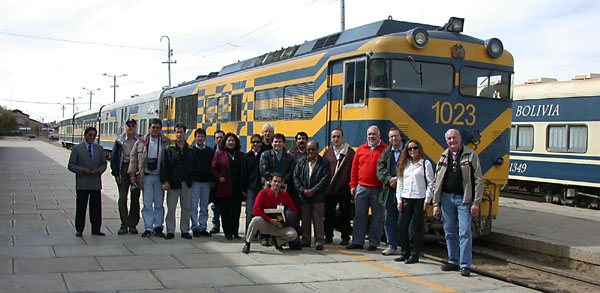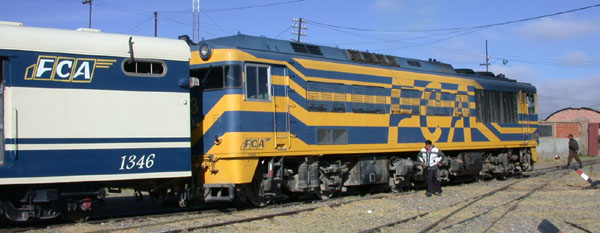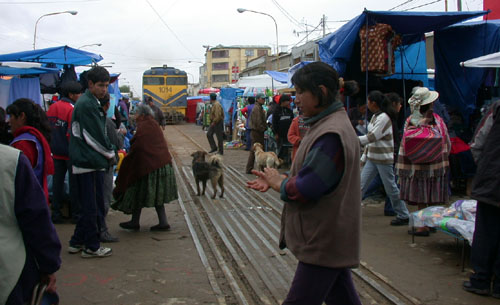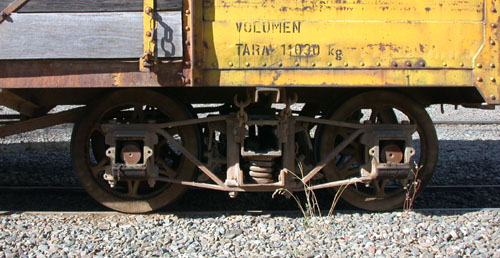|
Travels in Bolivia

Railroading in Bolivia is different. On my first
trip, we were travelling in a railcar and ran over a man who was sleeping,
dead drunk, between the rails. We stopped the train, backed up and the train
crew explained in Aymara, how fortunate he was not to have been cut up into
metre length pieces. The next day we were forced to make an emergency stop
because a man was tardy in getting out of our way. The long suffering train
crew quickly bailed off the car, caught the offender, and the conductor held
him while the brakeman beat him up.
Ottawa Valley Associated Railroaders
- OVAR, The Interchange, Summer 2003.In the last five years I have been asked to go to Bolivia, as a volunteer, to assist the government to develop a railway safety program. These have been challenging and worthwhile assignments — and I haven't been beaten up once! The railways in Bolivia run in the Amazon jungle on the borders of Brazil where tarantula spiders and venomous snakes are frequently seen. I always wear leather gloves when making an inspection — the spiders are known as "two hour spiders" — get bitten by one and you have two hours to say goodbye to your friends. At the end of the day one can have piranha soup and fried caiman for supper. Other parts of the system run on the Altiplano at over 12,000 feet where no trees grow. In fact the branch to Potosi goes over the highest railway summit in the world — Condor summit. At this altitude, there is a serious lack of oxygen and strenuous exercise has to be avoided until you are sure that your body has acclimatized. My most recent trip was in late April and May this year. I spent most of the time in the capital city, La Paz, but did manage to get out on one interesting railway journey. I gave a presentation to the Latin American Railway Association in La Paz and the next day was invited to go with the group on a special train that was put on by the Andina Railway from Viacha to Oruro. Viacha is the site of the locomotive works for the Andina Railway and is a short bus ride from La Paz. Short it might have been, but uneventful it wasn't. On the divided highway there had been an accident in which one car had gone over the side and a truck was broadside across the lanes in the opposing direction. The gas tank had a three inch gash in it and gasoline was pouring out on to the highway and creating a pool right where our bus stopped. Luckily nobody smoked and we were able slowly to make our way out of the potential conflagration. 
Our short special train was headed up by a three truck Mitsubishi locomotive. There was a restaurant car and the crew were anxious to make our four and a half hour journey a memorable one. As soon as we started there was a call for breakfast (desayuno). Here my poor Spanish got the better of me as I inadvertently ordered desayuno americano, which turned out to be the works — omelet, toast, fruit etc. Half an hour after returning to my seat I was called to lunch. Now, lunch in Bolivia is always very special, and this was memorable. We started with hearts of palm which was followed by chairo, the local speciality — a hearty soup made with vegetables, beans and corn and with a slice of meat as well as pork rind. The main course was roast chicken with salad, boiled potatoes and chuño — a potato which is freeze dried outside on the Altiplano and only available in this area. Dessert was, thankfully, a small portion of fruit. All the while we were passing small villages built of adobe (sun dried bricks) and with a back drop of the mountains of the Chilean Andes. The bare ground was dotted with llama and alpaca and there were a few lakes in which one could see flamingoes. At Oruro, the main line runs right through the local market and trains have to go very, very slowly to allow the traders time to remove their stalls to allow the train through. It was a novel experience to be sitting in a restaurant car and see the tops of the stalls brushing the window — and being watched by women wearing colourful shawls, petticoats and bowler hats. At least the train crew was well behaved this time and nobody was beaten up, probably because they would have been heavily outnumbered. All in all it was a pretty interesting trip, especially so because there are now no passenger trains on this route. Bolivia is a fascinating country to visit and I would thoroughly recommend it.
|

